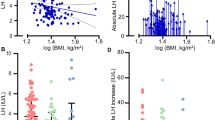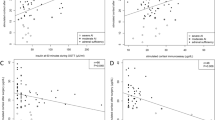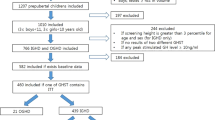Abstract
OBJECTIVES: To investigate the activity of the hypothalamic–pituitary–adrenal (HPA) axis in male obesity and its relationship with several prominent parameters of the metabolic syndrome.
DESIGN: A cross-sectional clinical study of the activity of the HPA axis in groups of obese males and normal-weight controls.
SUBJECTS: Seventeen obese non-diabetic males with a body mass index (BMI) >28 and eight normal-weight controls were examined.
MEASUREMENTS: Fat free mass (FFM) and fat mass (FM) were measured by bioelectrical impedance, and the waist-to-hip circumference ratio (WHR) was calculated in all subjects. Baseline samples were taken for sex hormone and lipid determination, and an oral glucose tolerance test (OGTT) was performed for glucose and insulin determination. The activity of the HPA axis was determined by the combined administration of human corticotropin releasing hormone (CRH) (100 μg) and arginine vasopressin (AVP) (0.3 IU).
RESULTS: As expected, FFM and FM and the WHR were higher in obese men than in controls, as were fasting insulin and stimulated (as area under the curve (AUC)) glucose and insulin concentrations. Baseline adrenocorticotropin (ACTH) and cortisol concentrations were similar in both groups, but stimulated (as AUC), ACTH was higher (P<0.05) in obese subjects than in controls, whereas no significant difference in cortisolAUC was present. Since the main differences between obese subjects and controls were present during the early 30 min of the test, the correlation coefficients between total and incremental ACTHAUC 0–30 min and cortisolAUC 0–30 min and all other variables were analyzed. A significant correlation coefficient was present between them and all anthropometric parameters, fasting insulin and insulinAUC, but not with androgens and gonadotrophins. In addition, a significant correlation was present between total and incremental ACTHAUC 0–30 min and triglyceride concentrations. However, after adjusting for BMI or FM values, all correlation coefficients became non-significant, except the one between incremental ACTHAUC 0–30 min and insulinAUC (P<0.05).
CONCLUSION: These findings indicate that obese men may also have an altered pituitary response to combined CRH/AVP stimulation, which appears to be predominantly related to body size and total body fat. ACTH hyper-responsiveness after CRH/AVP stimulation also appears to be related to hyperinsulinaemia, but underlying mechanisms of this relationship remain to be elucidated.
This is a preview of subscription content, access via your institution
Access options
Subscribe to this journal
Receive 12 print issues and online access
$259.00 per year
only $21.58 per issue
Buy this article
- Purchase on Springer Link
- Instant access to full article PDF
Prices may be subject to local taxes which are calculated during checkout
Similar content being viewed by others
Author information
Authors and Affiliations
Rights and permissions
About this article
Cite this article
Pasquali, R., Gagliardi, L., Vicennati, V. et al. ACTH and cortisol response to combined corticotropin releasing hormone-arginine vasopressin stimulation in obese males and its relationship to body weight, fat distribution and parameters of the metabolic syndrome. Int J Obes 23, 419–424 (1999). https://doi.org/10.1038/sj.ijo.0800838
Received:
Revised:
Accepted:
Published:
Issue Date:
DOI: https://doi.org/10.1038/sj.ijo.0800838
Keywords
This article is cited by
-
Impact of Adiposity and Fat Distribution on the Dynamics of Adrenocorticotropin and Cortisol Rhythms
Current Obesity Reports (2014)
-
Association of metabolic syndrome with reduced central serotonergic activity
Metabolic Brain Disease (2011)
-
Sex-dependent role of glucocorticoids and androgens in the pathophysiology of human obesity
International Journal of Obesity (2008)
-
Awakening Cortisol Response in Lean, Obese, and Reduced Obese Individuals: Effect of Gender and Fat Distribution*
Obesity (2007)
-
In vivo effects of corticotropin-releasing hormone on femoral adipose tissue metabolism in women
International Journal of Obesity (2007)



